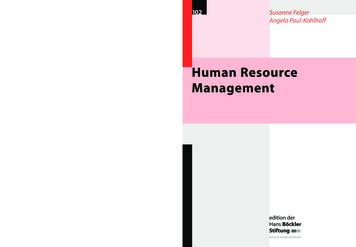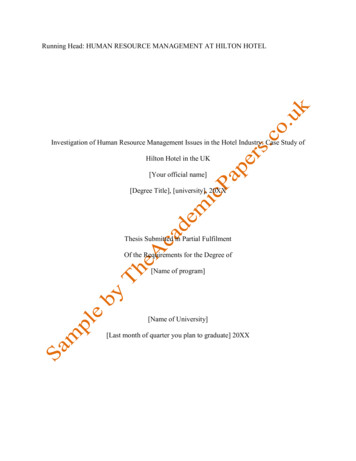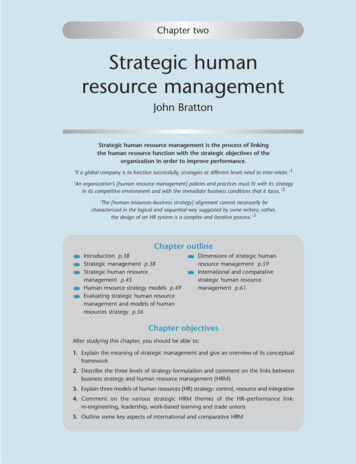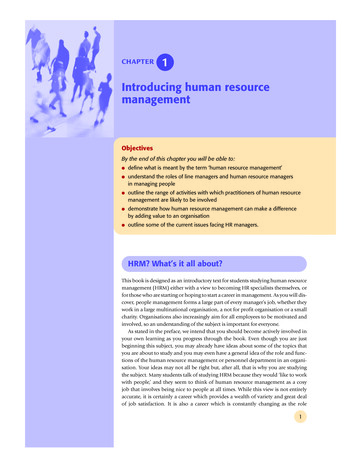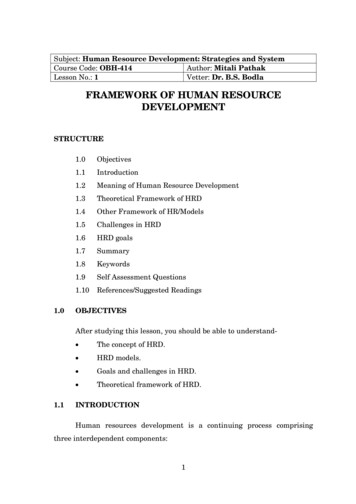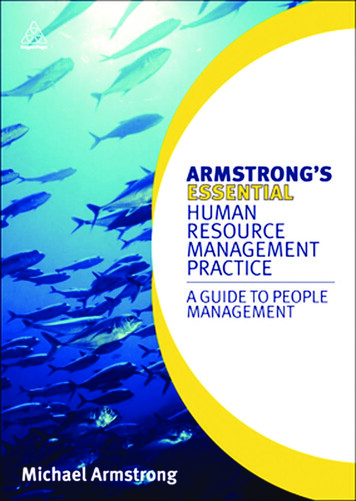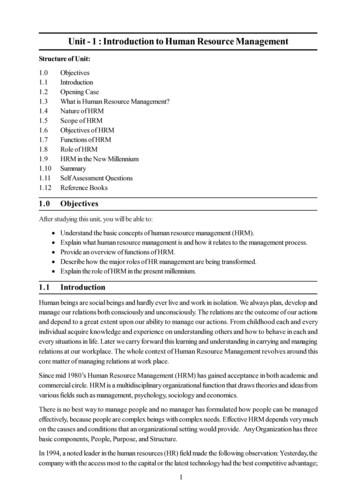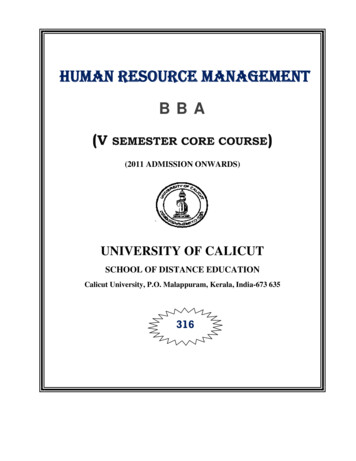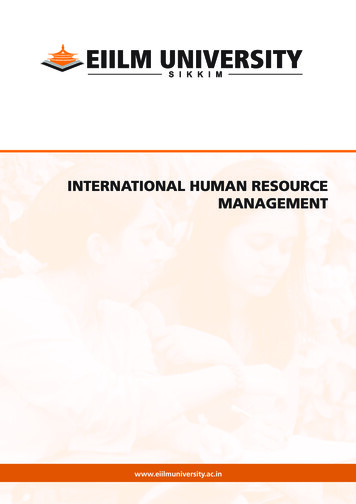
Transcription
INTERNATIONAL HUMAN RESOURCEMANAGEMENTwww.eiilmuniversity.ac.in
Subject: INTERNATIONAL HUMAN RESOURCE MANAGEMENTCredits: 4SYLLABUSIntroduction and OverviewThe scope of IHRM, Variables that Moderate Differences between domestic and International HRM.International Human Resource Management Approaches – The Path to Global Status – Mode of OperationInternational Staffing & Performance ManagementExecutive Nationality Issues- Staffing Policies – Issues in Staff Selection, Multinational PerformanceManagement – Factors associated with Individual Performance and Appraisal – Criteria Used for PerformanceAppraisal of International EmployeesTraining and Development& CompensationExpatriate Training – Developing International Staff and Multinational Teams, Approaches to InternationalCompensationLabor RelationsKey issues in International Labor Relations – Labor Unions and International Labor relations – The response ofLabor Unions to Multinationals – Regional Integration – The European Union (EU) – Regional Integration –The North American Free Trade Agreement (NAFTA)Issues, Challenges, and Theoretical Developments in IHRMManaging people in an International Context – India – Human Resources Issues in Multinational corporateSocial responsibility –concluding remarks, HR Practices in UK, USA and JapanSuggested Readings:1. Pemberton, William E. “Human Rights: Humanistic Visions, ImperialisticRealities,” University of Wisconsin-La Crosse.2. Stajkovic, Alexander D. and Fred Luthans “Business Ethics Across Cultures: A Social CognitiveModel” in Best Practices in International Business edited by Michael R. Czinkota and Ilka A.Ronkainen, Harcourt College Publishers.3. Pena, Leticia "Values in International Business: Faces of a Faceless Labor Force," Journal ofHuman Values, 4: 1, Sage Publications.
COURSE OVERVIEWThe Course is designed to build a knowledge base of the contemporary practices andissues in International Human Resource Management.This course examines how country level differences in factors such as labouremployment laws and trade union interact with national cultural expectations to createdistinctive employment systems between the countries. An implication that managingHuman Resource vary from country to country. It provides a thorough understanding ofhow to design and implement HR practices which meet the dual demand s of globalintegration and local flexibility. It will examine how re-sourcing, rewarding anddevelopment practices need to be adapted when working in a cross border environment.The aim of the course is to provide an understanding of the theoretical concepts and thepractical implications of international HRM and to take strategic view of some of thenew developments in international HRM. In particular it looks at HR's role on creatingorganizational capability on global scale and gives an overview of human resourcemanagement in an international environment. The emergence of the multinationalenterprise as a dominant institution in world economy has resulted in the importance ofunderstanding not only multinational enterprises themselves, but also the activities of thepeople working within these and similar multi-cultural organizations.This course examines how country level differences in factors such as labouremployment laws and trade union interact with national cultural expectations to createdistinctive employment systems between the countries. An implication that managingHuman Resource vary from country to country. It provides a thorough understanding ofhow to design and implement HR practices which meet the dual demand s of globalintegration and local flexibility. It will examine how re-sourcing, rewarding anddevelopment practices need to be adapted when working in a cross border environment.It will contextualize a diversity of human resource practices in corporate strategy andorganization development in conditions of globalization. On successful completion of thecourse students will be able to understand distinctive features of International HRM.Appreciate links between corporate strategy, organizational structure, corporate cultureand their impact on HRM in an international setting, the significance of cross-culturaldifferences in management theory and practice, explain the differences and similaritiesamong countries in the practice of major human resource management functions, anddescribe the major employment policies of multinational companies and the potentialproblems of cross-cultural differences.The detailed syllabus, analyzes the relevance of this knowledge base in today’s globalwork culture, wherein students learn to appreciate behavioral nuances and value systemsof the work force in a multi-cultural setting. The course requires the students to inculcatethe corporate etiquettes needed to manage people in an International environment.i
Learning Objectives1. Why is the study of International Human Resource Management important forbusinesses?2. How the course or practice of Human Resource Management is studied, understood orapproached? It is discussed under the head ‘ Approaches to International HumanResource Management’3. What is ‘International Human Resource Management’? Definition of ‘InternationalHuman Resource Management’ will give you a broad outline about what is in thissubject? You will also learn about PCNs, HCNs. and TCNs.IntroductionImportance of International Human Resource ManagementInternational business is dynamic. Business is crossing borders. Globalization is gainingmomentum. Markets are no longer protected from foreign competition. Markets are now openfor competition from both domestic and foreign firms. A large proportion of workforce arelocated in other countries away from their homes and home countries.For example, Ford Motor Company has half its employees outside the United States, Philipshas three-fourths of its employees working outside the Netherlands and more than half ofEricsson’s workforce is located outside Sweden.Issues of managing business are becoming more and more complex in the same pace asglobalization is taking placing. The unusual level of foreign competition in both domestic andforeign markets is forcing businesses to find and retain the competitive advantage. Finding andnurturing the suitable and capable human resources in the context of high competition at bothdomestic and international levels is high on the list of priorities of the top managements.Quality human resources are a must for implementing global competitive strategies. Firmsexpanding into international markets are put under additional pressure to manage their limitedresources and for such firms managing human resources is more essential than any other firm.Any problem is either created by people or must be solved by people. Having right people inthe right place at the right time is key to a company’s international growth.Approaches to International Human Resource ManagementCross-cultural Management: One approach stresses on cross-cultural management. Itexamines human behavior within organizations from an international perspective. Culturewhich varies from country to country at least on a few dimensions like family, work ethics,business practices etc. It makes all the difference.1
Comparative Industrial Relations: The second approach, which was developed fromcomparative industrial relations describes, compares and analyses HRM systems in variouscountries. It is a study of countries, their work patterns and managerial practices.Management of Multinational Firms: The third approach focuses on aspects of HRM inmultinational firms. In this the focus is on the management of multinational firms havingoperations in different countries and finding universal principles that apply to the operations ofthe multinationals across the world.What is International HRM?Let us first examine what activities constitute HRM. All those activities undertaken by anorganization to utilize its human resources effectively makes HRM. Those activities include: Human Resource PlanningStaffingPerformance managementTraining and developmentCompensation and benefitsLabor relationsThe above activities will have a change whenever a firm or its HRM goes international.Three Dimensions of International HRM activities:1. Procurement, allocation, and utilization of human resources. These are listed under HRM.2. Three national or country categories involved in international HRM activities are: the host country where a subsidiary may be located, the home country where the firm is headquartered, and, the ‘other’ countries that may be source of labor or finance.3. The three types of employees of an international firm: the host country nationals (HCNs), the parent-country nationals (PCNs), and the third country nationals ( TCNs).Thus, for example, IBM employs Australian citizens (HCNs) in its Australian operations, oftensends US citizens(HCNs) to Asia-Pacific countries on assignment, and may send some of itsSingaporean employees on an assignment to its Japanese Operations (as TCNs).Model of International HRMInternational HRM has been defined by Morgan as the interplay among three dimensionsnamely human resource activities, types of employees, and countries of operation.Activities of HRM in international scene are the same as those of domestic HRM except that inthe former the activities are done in home country.2
The relevant issues that arise out of operating in different countries and employing differentnational categories of workers is a key variable that differentiates domestic and internationalHRM rather than anything else. Failures of several international firms are linked to the poorinternational human resource management. Study conducted by Desatnick and Bennet on largeUS multinational firm confirm the above statement.Now there is a tendency that domestic firms are taking the models offered by internationalHRM to manage diversity of workforce. But it needs some modification while applyingprinciples of managing domestic workforce diversity to international HRM.SummaryYour have learned in this lesson that:The importance of study of International Human Resource Management. Globalization ofbusiness makes this study very important.The approaches to study were learnt. Three approaches are: Cross-cultural management, Comparative industrial relations, and, HRM in multinational firms.The function of International Human Resource Management was defined. International HRM isthe interplay among themselves the three dimensions: Human resource activities, Types of employees, and Countries of operation.The questions that must prick your mind1. Is the study of International HRM for a Management student? How?2. International HRM looks very vast? How can one study it?3. What constitutes International Human Resource Management?3
LESSON 2International HRM vis-à-vis Domestic HRM: Core ConceptsLearning Objectives1. What activities in the ‘International Human Resource Management’ are over and above thedomestic HRM? How is it different from the within-the-nation practice of HRM?2. Familiarize you with the extra HR activities that are incremental to domestic HRM.3. Why broader perspective is necessary for International HRM?4. How employees personal or family lives are a focus in Internal HRM unlike domestic HRM?5. What are different ways of workforce mix of expatriates and locals?6. Does risk involved in International business affect HRM?7. What are the external influences that impact on International HRM?IntroductionThere are seven factors, which differentiates international HRM from domestic HRM. Theyare:1. More HR activities2. Tax Laws3. International Relocation and orientation4. Administrative services5. Relationship with Host-government6. Provision of language translation services7. More involvement in employee’s personal lives8. Risk Exposure9. More external influencesWe will study each of the above one after the other.More HR ActivitiesInternational environment requires the HR department to undertake more HR activities thanthose in domestic HR. They are: international taxation, international relocation and orientation,administrative services for expatriates, host government relations, and language translationservices.Tax LawsExpatriates, the nationals working in different country other than their native land are subject tolaws of the both the nations, both home and host countries. The HR department should designthe remuneration so as to equalize the impact of taxes in such a way that there is neither taxincentive or disincentive. Tax laws are widely different in different countries. Tax liabilities inmany cases arise after the foreign assignment is finished. To avoid tax problems, generally theservices of an accounting firm are taken.4
International relocation and orientationInternational relocation and orientation involves activities like imparting of pre-departuretraining; providing of immigration and travel details; providing housing, shopping, medicalcare, recreation, and schooling information; and finalizing compensation details such asdelivery of salary abroad, determination of various international allowances, and taxationtreatment.The above issues may give rise to problems if considerable time and care are not given onthem.Administrative ServicesA multinational firm also has to provide administrative services for expatriates in the hostcountry in which it operates.The policies and procedures with regard to these services are not always clear cut and mayconflict with local countries. An ethical and legal practice in one country is an unethical andunacceptable practice in another.For example, AIDS test in one country is a must in one country but the same is unacceptable foran employee of another country.These issues must be resolved by the HR function. Such issues add complexity to the provisionof services to the employee under relocation.Host –Government RelationsHR department should take care of relationship with host government employees sinceparticularly in developing nations work permits and other certificates are more easily obtainedwhen a personal relationship exists between relevant government employees and multinationalmanagers.Provision of Language Translation ServicesProvision of language translation services for internal and external correspondence is anadditional international HR activity. It is, if necessary, expanded to provide translation serviceto all foreign operation departments within the multinational.More Involvement in Employees’ Personal LivesThe HR professional or HR department has to see that the expatriate employee understandshousing arrangements, health care and all aspects of the compensation package provided forthe assignment ( like cost-of- living allowances, premiums, taxes etc.) Many multinational havean ‘ International HR Services’ section that coordinates administration of the above programsand provides services for PCNs and TCNs such as handling their banking, investments, homerental while on assignment, coordinating home visits, and final repatriation.In the domestic service, the involvement of HR with employee’s family is limited. In theinternational setting, the HR department should know the personal life and needs of theemployee in order to give necessary support.For example, in the cases of requirement of marriage certificate for issue of visa for anemployee being sent on foreign assignment, the HR department will do advise the bachelors as5
to how they can remain in the selection process for assignment. Apart from providing housingand schooling in the assignment location, the HR department needs to care of the left-behindchildren with regard to their schooling and boarding. In areas of remote location, the HRdepartment should arrange for recreation facilities also. Generally in domestic setting, all theseare the responsibility of employee himself. Changes in Emphasis as the workforce Mix of PCNsand HCNs varies.Over a period of time as the foreign operations grow and evolve, the emphasis on certainactivities change. More local trained people become available. Resources previously allotted onsuch activities as expatriate taxation, relocation etc will be transferred to activities such aslocal staff selection, training, management development etc. It is how the responsibilities andactivities of local HR become broader.Risk ExposureAn employee sent on foreign assignment may fail and come back to home country. Costs ofsuch failure are three times higher than those in domestic service. Such failure also causesindirect costs like loss of market share and damage to customer relationships. Terroristproblems should also be properly assessed and safety should be planned by HR function.Emergency evacuation plans should be devised by HR.More External InfluencesMajor external factors like type of government, state of the economy and accepted practices ofdoing business in host country influence the international HRM of multinational firms. Forexample, a host country can dictate hiring terms. In Malaysia, the local Malays should beadequately employed and periodical returns should be sent on employment patterns of differentethnic groups.In developed countries, the labor is expensive and certain legal requirements have to be met. Inless developed countries, the labor is cheap and employment regulations are relatively liberaland consequently the burden on HR management is less. The subsidiary HR manager shouldalso learn the local business conventions and code of conduct like in the areas of gift-giving etc.SummaryInternational HR concerns itself with more activities, like international taxation, internationalrelocation and reorientation, administrative services for expatriates, host country governmentrelations, and language translation services which are not there in domestic HR. Since theinternational HR cuts across more than one nation, a broader perspective in stead of singlecountry specific mindset is necessary.It touches upon personal and family lives of the employees on transnational assignment. Certainitems of work in international HR which were in the beginning slowly lose importance as thefirm matures.Unforeseen events like wars etc should be properly thought of. External uncontrollable factorslike changes in host country economy influence the international HR.6
The questions that should prick your mind1. What are the two important activities of international HR that are different fromdomestic HR?2. Why is a greater degree of involvement in employee’s personal lives inevitable in manyinternational HRM activities?7
LESSON 3International HRM vis-à-vis Domestic HRM: Moderating VariablesLearning Objectives1. The factors that increase or decrease the differences between domestic and internationalHRM.2. How cultural environment impacts international HR as different from domestic HR?3. What is the importance of cultural awareness?4. How do variables like type of industry, the dependence of the multinational on its homecountry and attitudes of senior managements moderate the difference between domesticand international HR?5. Is the role of international HR expanding?IntroductionWe have so far learnt that because of involvement of different countries and different nationalsin HR at international level the subject has become complicated when compared it to domesticHR. Besides this, there are other factors also which widen or make narrower the differencebetween international and domestic HR. Now let us take a look at each of them.There are four variables that moderate (i.e. either diminish or accentuate ) the differencesbetween domestic and international HRM. Cultural EnvironmentThe industry with which the multinational is primarily involvedThe extent of reliance of the multinational on its home country domestic marketThe Attitude of Senior ManagementWe will examine each of above variables.1. Cultural EnvironmentCulture is a Shaping Process Members of a group or a society share a distinct way of life withcommon values, attitudes, and behaviors that are passed over time from generation togeneration in a gradual, yet dynamic process. A Person is Not Born With a Certain Attitude Heacquires it through socialization process and hands it down to the next generation.Culture is so invisible, but affective a process that one is not always aware of its effect onvalues, attitudes, and behaviors. By reading a novel or story about a group of men of aparticular culture, the differences can not be understood.The differences of culture can be better appreciated only when one directly deals with them inreal life- like living with them or interacting with them. This is called ‘culture shock’ which isphenomenon experienced by people moving across different cultures. The new environment8
requires many adjustments in a relatively short period of time, since it challenges people’sestablished thinking pattern to such an extent that their identity especially in terms ofnationality, comes into question. People experience shock reaction to new cultural experiences.This is because people misunderstand or do not recognize important cues.Culture shock can lead to negative feelings about the host country and its people and desire toreturn home. International business involves the interaction and movement of people acrossnational boundaries.Awareness of cultural differences is essential for those going out on foreign assignment as wellas for those managing the HR function. One issue of cross-cultural understanding is thatrelating to distinction between emic and etic aspects. Emic is about culture-specific aspects ofconcepts or behavior. Etic is about culture-common aspects. Etic approach led to convergencetheory. Etic approach is based on the assumption that the principles and practices ofmanagement are universal and hence applicable to every land. Local differences should bechanged to meet the universal practices.Emic approach led to divergence theory. Principles and practices are not universal in that theyare divergent and hence local differences should be allowed. Etic assumptions led to theerroneous prediction that Japan would fall behind in industrial performance unless it adaptsitself to the US practices which were thought to be universal. Appreciation of cultural diversityas assumed in emic or divergence approach is as necessary as the appreciation of universality ofcertain principles or cultural commonalities as in etic or convergence approach.Importance of Cultural AwarenessIt is now generally recognized that culturally insensitive attitudes and behaviors stemming fromignorance or from misguided belief ( ‘ my way is the best’ or ‘what works at home will workhere’) are not only improper but cause painful business failures. Hence HR managers and bothheadquarters and host country should be aware of the cultural differences. Activities such ashiring, promoting, rewarding and dismissal will be determined by the practices of the hostcountry. Generally a local person is appointed as HR manager who should report to the bossrelocated from headquarters. In such cases what the local HR manager does may not agreeableto the boss from the headquarters.Suppose a local HR manager is Thailand has appointed all his relatives in the office; it is a follyof favoritism or nepotism as per boss’ home country practices, but it is a responsibility of localHR manager to help his relatives.Another example of bringing home country ideas to host country and its subsequentrepercussions or failures is related to the banning of chewing of betel in Papua of New Guinea.In a multinational company operating in New Guinea has noticed that more accidents weretaking place among drivers operating heavy earth moving equipment.The expatriate manger linking accidents to use of stimulants like betel-chewing, has banned it.But in another move to reduce accidents, free coffee was provided at loading points and9
the drivers were required to alight from the vehicles at these locations to drink it. What theexpatriates did not realize was that betel nut like culturally acceptable coffee was a stimulantbut the drivers chew betel nut to cover the smell that comes out of drink of alcohol. Out ofincorrect understanding, they banned a wrong thing in an attempt to correct a situation but it didnot help. Cultural differences cause adjustment and handling problems to both expatriates andfamilies. The HR managers should help the expatriates prepare for these differences.2. Industry TypeIndustries are of two types: Multi-domestic Industry Global Industry.Multi-domestic industry is one in which competition in each country in independent of thecompetition in other countries like retailing, distribution, insurance etc.Global industry is one in which firm’s competition in one country is significantly influencedby its position in other countries like those of commercial aircraft, semiconductors, and copiers.Global industry competes at global level. A firm of a global industry integrates its activities ona worldwide basis to capture the linkages among the countries.In multi-domestic industry, the international firm converts its global strategies into domesticstrategies. In a multi-domestic industry, the HRM function is primarily domestic in structureand orientation.The HR function of a multinational company in a global industry should be structured to deliverinternational competitive advantage.A truly international conception of human resource management would require the followingsteps:1. The parent organization should recognize that their own assumptions and values ofhome country are reflected in the way they manage human resources in host country.2. The parent should recognize that their peculiar ways are not universally applicablethough such ways have their strengths and weaknesses.3. The parent organization should also recognize that their foreign subsidiaries may haveother preferred ways of managing people, which may neither better or worse, but maybe effective locally.4. The cultural differences should be made discussable and usable.5. All should believe that cross-cultural learning will produce effective ways of managingpeople.By the above steps, a multinational company will be able to work through the difficultiesinherent in such a strategy.3. Reliance of The Multinational on Its Home-Country Domestic MarketHR practices are influenced by the extent to which the multinational depends on the homecountry domestic market. Global market perspective is seen as dominant in the operations10
of the many multinationals. For many firms, the small size of their home market is the primaryreason for exploring international markets. Many US companies because of the larger size oftheir home country have expanded relatively less into foreign markets as compared to those ofSwitzerland, Canada, Britain, and Sweden.4. Attitudes of Senior Management to International OperationsThe last but not the least of variables that moderate the differences between international anddomestic HRM is attitudes of the senior management.The real change should occur in the attitudes of the senior management so as to trulyinternationalize the HR function. If senior management is not strongly oriented towardsinternationalization, the importance of the international operations may be de-emphasized. Suchmanagements may also erroneously assume that what is practiced in the domestic HRM istransferable to international HRM. It causes problems and also business failures. Now thechallenge for HR manager is to work with top management to global mindset.Expanding the Role of HRM in International FirmsOne study by Bhat et al assessed how and whether HR department and staff are involved inplanning at the strategic and corporate levels.The study concluded that HR involvement at the corporate level tended to informal, limited inscope and heavily dependent on the competence and personal characteristics of the senior HRmanager. The HR manager played a major role separate from the functional area. Staffing wasthe main area in which HR manager was involved, strategy formulation; other traditional HRareas ( e.g. compensation and evaluation of manager performance) were viewed as generalmanagement concerns and not primarily HR related.At SBU ( strategic business unit- is a single or group of products or a single or group ofmarkets) , the HR department was more involved in strategic planning; its emphasis was onhow HR staff could help implement a strategy.HR staff should be globally oriented and a global perspective of HR function through a broaderview of issues enables the development of more effective corporate policies.The need for a global perspective applies to both the individual HR manager and HRdepartment. Towards this end, the HR managers should be transferred from headquarters tointernational operations, not into subsidiary HR departments but into other line positions thatwill broaden their perspectives. Moving HR staff from the subsidiaries into headquarters isanother way of encouraging headquarters HR staff to appreciate the international operations ofthe firm and to develop the policies and activities to support staff throughout the entire globalnetwork. Wherever companies can not afford transfer of staff to international operations of thefirm, other ways like an annual visit to key foreign subsidiaries. Larger multinational schedulefrequent meetings of corporate and subsidiary HR managers as a way to foster corporateidentity and to ensure greater consistency in global HR practices.11
But in one survey ( Reynold’s survey of thirty five major US multinationals) it was found thatHR professionals with international experience were typically narrowly focused on expatriatecompensation. An expanded view of the role of HRM in international operations is required.One Caution: Always churn in your mind the concepts and apply them over the latest eventsreported in Economic Times or Business
Subject: INTERNATIONAL HUMAN RESOURCE MANAGEMENT Credits: 4 SYLLABUS Introduction and Overview The scope of IHRM, Variables that Moderate Differences between domestic and International HRM. International Human Resource Management Approaches – The Path to Global Status – Mode of Operation . T


